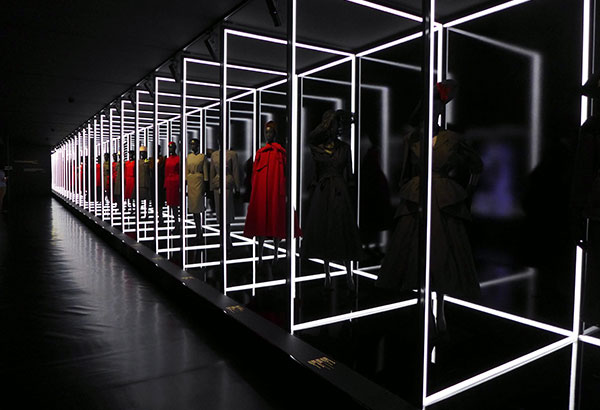I Adore Dior!

“I think of my work as ephemeral architecture, dedicated to the beauty of the female body,” said Christian Dior.
What do Marilyn Monroe, Elizabeth Taylor, Brigitte Bardot, Jackie Kennedy, Lady Diana, Charlize Theron, Marion Cotillard, and many other luminaries have in common? They have all appeared in Dior. This year is the 70th year of the venerable House of Dior, its largest retrospective ever staged and the first in France in 30 years, entitled “Christian Dior: Couturier du Rêve (Designer of Dreams),” now showing at the Musée des Arts Decoratifs until January next year.
The display presents the chronological sequence from the time Dior established his house in 1947 until today. Christian Dior himself and his worthy successors are true architects of fashion. Yves Saint Laurent, Marc Bohan, Gianfranco Ferré, John Galliano, Raf Simons, and Maria Grazia Chiuri have all interpreted the Dior allure, reflecting the modernity and attitudes of their time.
Museum director Olivier Gabet says, “The goal of the exhibition is to show the source of creation and the breadth of culture that Christian Dior and the designers who succeeded him possessed. They really explored the history of art. It’s important for the public to understand that fashion isn’t ‘easy.’ Dior, and the others, made a point of bathing in culture. He understood the complexity of things, but what he loved was simplicity.”
Christian Dior (1905-1957) was born in Granville, a seaside town in northern France. Always interested in art, he opened a gallery at an early age. The birth of the House of Dior coincided with the golden age of fashion photography, with photographers Richard Avedon, Louise Dahl-Wolfe, and Irving Penn, among others. Models wearing Dior struck dramatic poses for the camera. Princess Margaret chose to be in Dior for the official photograph of her 21st birthday, taken by Cecil Beaton.
Christian Dior’s first haute couture collection in 1947 radically changed postwar masculine clothes. The iconic Bar suits, which featured ample busts, nipped-in waists, soft shoulders, and sculpted hips, have transcended time and been reinterpreted by the different artistic directors as an homage to the one who started it.
Marc Bohan, after working as a designer for Jean Patou and Robert Piguet, was appointed artistic director of Dior in 1960. His slim look was well-received. Elizabeth Taylor chose 12 dresses from the collection. He was favored by Princess Grace of Monaco and her daughter, Caroline.
Gianfranco Ferré was the first Italian to be appointed director of a French couture house (1989). Ferré revived a waning interest in haute couture at the time when ready-to-wear clothes were becoming more attractive. Trained as an architect, he shared Dior’s skill in well-constructed garments. Both he and Dior “created powerful effects with simple shapes.”
John Galliano, the “entrant terrible” of British fashion, joined Dior in 1996. While this sent shockwaves throughout the entire industry, the “eccentric punk designer” achieved rock-star status. In 1999 to 2000, his Matrix and Clochards collection were extravagant, at a time when six million people were unemployed in France. When questioned about his excessiveness, his reply was “I prefer bad taste to no taste.”
Raf Simons, a Belgian designer and a master of minimalism, showed his first collection in July 2012. He proved to be a great interpreter of Dior’s romanticism. He made the Bar suit in a trouser version, returning to the masculine-feminine style. He was an anti-star and disliked being in the limelight. “I don’t have any stories of the day or concepts to propose,” Simons said. “I believe in a modern-day aesthetic. A woman is not interested in clothes that don’t let her move. It’s less dramatic. I don’t design a style for the pages of fashion magazines or a moment in the spotlight on the red carpet.” A former industrial designer, Simons focused on the clothes’ architecture. He created color blocks, punctuated with delicate embroidery.
Maria Grazia Chiuri, the current artistic director, is the first woman to be appointed to the position. She is convinced that the new Dior woman is “desirable, fragile, but self-confident, with real inner strength.” While Galliano orchestrated Dior’s 60th anniversary with an artists’ ball at the Versailles Orangerie, Chiuri marked the house’s 70th year with a collection inspired by Monsieur Dior’s travels around the world.
The exhibit is as grand and impressive as the House of Dior itself. One cannot help but stand in awe of the masters who moved, and continue to move, the fashion world with such power and influence. Christian Dior is truly the “Designer of Dreams,” and for us poor mortals, we can do nothing but dream.
* * *
You can contact me at cecilialicauco@gmail.com. Follow me on Instagram: cecilialicauco2.




















